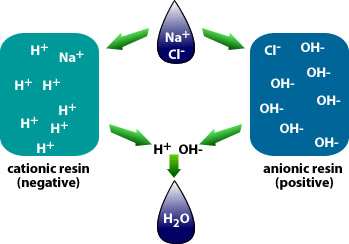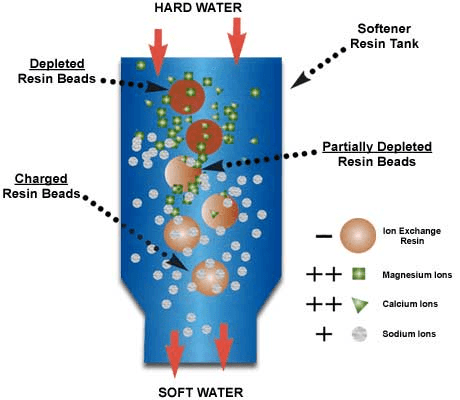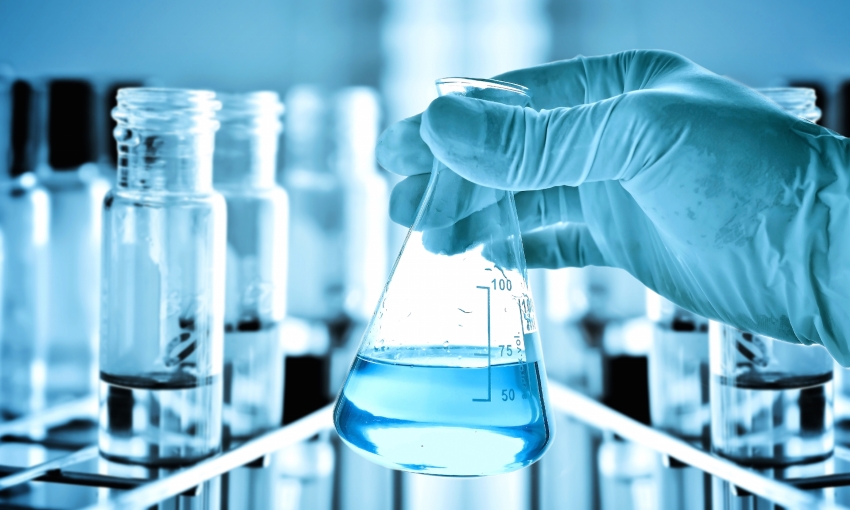Ion exchange resins are materials — composed of organic polymer beads or membranes — which simultaneously trap and release ions for the purpose of purifying or decontaminating liquids.
Ions are defined as atoms or molecules containing an uneven amount of electrons, therefore resulting in a positive or negative charge. Positively-charged ions are referred to as cations, while negatively-charged ones are known as anions. The process of ion exchange simply refers to the attraction of ions, and the replacement of these ions with those of an opposite charge, to a specialized material. In addition to human-created resins, ion exchangers include naturally-formed adsorbents such as zeolite, clay, and soil humus.
The image below shows an example of the ion exchange process, particularly to remove sodium chloride from water (desalination).
 Image credit: HMDigital
Image credit: HMDigital
Resin Composition
Ion exchange resins are typically produced as small beads fabricated from a polymeric material (usually polystyrene or [less frequently] acrylic polymers). During the polymerization process, styrene is combined with divinylbenzene (DVB) to form a crosslinked polymer; this crosslinking process results in increased stability when compared to non-crosslinked materials. Active groups are added to the resin after the polymerization process to determine the type of desirable ion exchange. Each copolymer resin bead possesses a gel-like structure and is able to expand and contract in liquids; they also contain numerous surface pores for trapping ions.
Non-bead resins are manufactured as membranes consisting of densely cross-linked individual resins. These are mainly used for specialty applications such as electrodialysis.
Applications
Ion exchange resins are primarily used as integral parts in the water treatment process in both consumer and industrial settings. Water softening systems use resins to replace magnesium and calcium — two common elements of hard water — with sodium molecules. Resins can also be used to purify water by replacing metals such as copper, cadmium, and lead with benign sodium or potassium molecules.

The water softening process: highly positive Mg and Ca ions are exchanged for less-positively charged Na ions.
Image credit: ML Ball
Along with its place as a desirable drinking water, purified water is also highly valued in industrial environments. In boiler feedwater systems, for example, ionized or hardened water results in buildup of scale over time, causing reductions in efficiency and reliability and, eventually, catastrophic boiler failure. Therefore, the removal of ionic impurities from feedwater is critical to the boiler's operation.
In addition to water treatment, resins are also an effective means of separating rare earth metals. Less-common applications include use in pharmaceutical manufacturing, food processing, and as active catalyzers in laboratories.
Specifications
Types
There are four types of ion exchange resins, as described in the table below. Resins act on chemical solutions which are the opposite of the implied solutions in their names; for example, a strong acid cation (SAC) resin is used to neutralize strong bases, while a weak base anion (WBA) resin is used to neutralize weak acids. Mixed resins contain a combination of cation and anion resins.
|
Resin type |
Ideal pH range |
Applications |
Notes |
|
Strong acid cation (SAC) |
All |
Softening; full demineralization; decationization. |
Often combined with WAC to provide efficient full demineralization. |
|
Weak acid cation (WAC) |
7-14 |
Dealkalization; partial demineralization; high-hardness and high-alkalinity waters. |
Superior regeneration; efficient. |
|
Strong base anion (SBA) |
All |
Softening; full demineralization. |
Treated with ammonium functional groups after polymerization. |
|
Weak base anion (WBA) |
0-7 |
Dealkalization; removal of sulfuric, nitric, and hydrochloric acids. |
|
Standards
Ion exchange materials may be produced and tested using various standards, including:
ASTM D1782 - Test methods for performance of cation-exchange materials
ASTM D5627 - Test method for water-extractable residue from ion exchange resins
ASTM D4266 - Test methods for precoat capacity of powdered ion exchange resins




